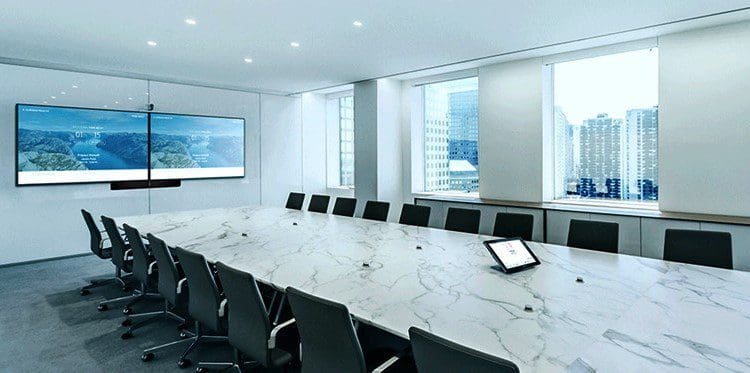10 years ago, if you’d mentioned to anyone that the global corporate landscape would transition massively to hybrid workplaces with remote working, people would think you’re joking. Or being wishful. One thing they definitely wouldn’t call you is a visionary.
Fair enough, as no one could have predicted a global pandemic. But as things are, working remotely looks like it’s here to stay. It will be present in different forms, most popularly in the hybrid model. A recent Accenture report states that 83% of the 9,326 workers surveyed say they would prefer a hybrid model, within which they can work remotely at least 25% of the time.As we all know, the hybrid workspace will take the best of both worlds, i.e working from an office, and working remotely. Many offices have had to go with the flow and adapt to this style of work. But with so much information out there, guiding us towards a hybrid future, corporations would do well to prepare well in advance. Winging it is no longer an option, as most leading companies have already started to prepare for hybrid work life. In the same study, 63% of high-revenue-growth companies have enabled productivity anywhere workforce models. It’s the negative or no-growth companies that are still focused solely on either on-site or remote.
Factors That Will Influence Our Hybrid Future
1. Desire for Creativity
Even before the pandemic, employees were becoming increasingly disenchanted with traditional meeting spaces. They were adopting huddle spaces, smaller breakout rooms, and other such variations. The appeal of such spaces lies in how they can foster intimacy and creativity, which boost productivity. But social distancing requirements mean that larger rooms will have to be used to stay in line with the “two-metre rule”.
Also, this isn’t to say that standard meeting rooms will disappear indefinitely. Many offices prefer that format and find it more efficient and productive. But these will have to be equipped with immersive AV technology that creates a deeper human connection and inspires collaboration. Offices must have the appropriate audio-visual technology installed to enhance brainstorming sessions. Perhaps even the entire layout of the office will have to change to fold around the AV backbone.
2. Emerging Tools and Technology
These developments have led to the adoption of new tools and technologies, and innovative applications for the same. But while many companies are building or acquiring tools to support hybrid workspaces, very little is being done to train people on how to use them. Many employees are faced with difficulties in using technology such as video conferencing tools and other virtual collaboration tools. It’s time for companies to take note of this and plan training sessions for their employees to become fluent in these technologies.
Audio-visual technology is at the forefront of these developments. But offices must take measures to reap its benefits. They must provide a secure and reliable connection, share access to important data, and enable streamlined communication. Alternately, the organization must embrace powerful assisted or self-service options that provide support to the employee on the ground, exactly when required.
Doing all this requires the help of experienced AV professionals to create powerful solutions that have inbuilt ease-of-use features as well as the on-demand support infrastructure today’s employees need.
3. The New Generation
Generation Z as a group has recently entered the workforce. They’re tech-savvier than any of their predecessors – but still, place a lot of importance on face-to-face interactions. Of course, as a generation looking for leadership and hands-on mentorship, why wouldn’t they? A survey found that 83% of the respondents preferred to communicate with their managers in person. Thus, there must be ways to create a more personal way of interaction for these new employees to excel. AV technology is a force that can seamlessly facilitate meaningful exchanges between employee and mentor, even in the hybrid workplace. Robust AV solutions can also power interactions with a wider scope, for instance, CEO addresses or company-wide townhalls. These also feel the need for human connection of the new generation of workers.
4. Engagement Will Take Centre Stage
Did you know that human beings use face perception as the basis of much of their social exchange? It’s true. We are significantly stimulated by faces. Thus, one drawback to remote working that arose was the feeling of alienation many workers felt. Audio-Visual technology will take the lead in creating more engaging experiences for remote workers. It will help them multi-task and communicate simultaneously, meetings will be facilitated, and more. Workers will feel less distracted and fatigued.
Technology like this will help bridge the gap between those split between working at home and in the office. It will do this while providing a consistent and immersive experience. Essentially, the future will see an upsurge in technology to increase engagement, and engagement will be the main force behind productivity.
5. AV Will Be the Backbone of a Hybrid Future
We can see that AV technology will help people enjoy a flexible and autonomous hybrid work life. Audio-visual technology will give employees the freedom they need along with tools to enjoy collaboration and connection. AV technology will play a key enabling role in enhancing communication, collaboration, employee enablement, support and help, and more.
Companies must invest in reliable and user-friendly AV systems. That will allow in-office employees to interact with remote employees. It’s productive and will be a natural way for them to communicate. It will help coordination too. Even client communications can benefit. There are also many other interesting ways to adopt AV tech for a hybrid workspace. An example is digital whiteboarding, which helps conduct collaborative training sessions. One could capture the entire session across the video while streaming. Many digital whiteboards digitally store notes which can be accessed later on.
AV tech holds the potential to be the driving force behind a thriving hybridized future. If you want to discuss implementing these for your enterprise, reach out to us, and let’s talk.


